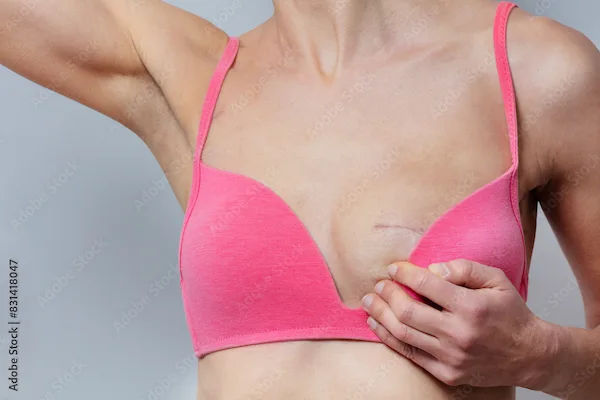Breast Rash Concerns
Understanding the concerns related to breast rash can help tackle it effectively. Learn all about breast rashes, from causes and symptoms to diagnoses and treatments available.

Written by
Last updated on 3rd Jul, 2025
The term breast rash denotes any change in colour, redness, or texture of the skin in the breast region. Most rashes are harmless and related to general skin ailments, but they may also be a symptom denoting various infections or, in some instances, even inflammatory breast cancer. Knowledge of the possible causes and manifestations of breast rashes is the foundation of the management process.
Breast rashes can be caused by infections, allergies, irritants or illnesses and may come with a burning sensation. The skin under the breasts is dark and has more sweat glands, making it a perfect place for the development of fungal infections and heat rashes. Skin allergies to creams or lotions used in skincare or to washing powder and other detergents are also other causes.
Types of Breast Rashes
Breast rashes may present in different appearances depending on the underlying etiologies. They could be infections, allergies or irritation rashes. It is crucial, thus, to understand the nature, form or type of rash in order to know the right treatment to be given.
1. Infectious Rashes
Caused by bacterial or fungal infections, these rashes often require medical intervention:
Fungal Infections (Candidiasis): Thrive in warm, moist environments, causing red, itchy patches with a white discharge.
Bacterial Infections (Cellulitis): Result in swelling, pain, and redness, sometimes accompanied by fever and chills, requiring antibiotics for treatment.
2. Allergic Rashes
Triggered by allergens found in clothing, detergents, or skincare products:
Appear as red, raised, and itchy lesions.
Avoiding allergens is the best way to prevent recurrence.
3. Irritant Rashes
Result from prolonged exposure to sweat, friction, or harsh chemicals:
Often lead to redness, chafing, and discomfort, especially in humid weather.
Wearing breathable fabrics and maintaining proper hygiene can help.
Symptoms to Watch
While mild breast rashes may cause discomfort, severe symptoms warrant immediate attention. These include:
Fever or chills, indicating a possible infection
Rapidly spreading redness or streaks
Open sores or wounds that do not heal
Signs of systemic infection, such as fatigue or unease
It’s important to keep in mind that mild rashes typically involve localised redness, itching, or slight discomfort and can often be managed with home remedies. Severe rashes, on the other hand, are accompanied by significant pain, swelling, or systemic symptoms and require medical evaluation.
Common Causes of Breast Rashes
Breast rashes can arise due to various underlying factors, ranging from infections to irritants and allergies. Recognising the root cause is essential for effective treatment and prevention.
Fungal Infections: Warm and moist areas under the breasts create an ideal environment for Candida (fungi) overgrowth, resulting in red, itchy patches often accompanied by a whitish discharge. Proper hygiene and antifungal treatments are key to managing these rashes.
Bacterial Infections: Conditions like cellulitis cause pain, warmth, swelling, and redness. These infections require prompt medical intervention, often with antibiotics, to prevent complications.
Further, allergic reactions to soaps, lotions, detergents, or fabrics can lead to itchy, inflamed, and red skin. Identifying the specific allergen and avoiding its use is vital in resolving these rashes effectively.
Another thing to keep in mind is that hot weather and prolonged moisture can result in heat rashes under the breasts as well. These manifest as small, itchy bumps and are often exacerbated by tight or synthetic clothing. Staying cool, wearing breathable fabrics, and keeping the area dry can alleviate symptoms and prevent recurrence.
Diagnostic Approaches
Diagnosing the cause of a breast rash involves a careful and systematic approach by healthcare providers to ensure accurate identification and treatment.
Clinical Examination: A detailed physical examination is the first step. Healthcare providers assess the appearance, location, and characteristics of the rash, such as redness, texture, and any accompanying symptoms like swelling or pain. They also consider the patient’s medical history, including recent exposure to potential irritants, infections, or any pre-existing conditions.
Skin Biopsy and Cultures: For persistent or atypical rashes that do not respond to initial treatments, further diagnostic tests may be required. A skin biopsy involves taking a small sample of the affected skin for laboratory analysis to detect inflammatory or malignant conditions. Microbial cultures can identify specific bacterial, fungal, or viral infections, guiding targeted therapy.
These advanced diagnostic tools are essential for addressing complex or recurring cases effectively.
Treatment Options
Over-the-counter treatment solutions include:
Antifungal creams for yeast infections
Hydrocortisone creams for mild inflammation
Calamine lotion to soothe irritation and itching
Prescription medications include:
Antibiotics for bacterial infections
Stronger corticosteroids for severe allergic reactions
Antifungal medications for widespread fungal infections
Home remedies and lifestyle changes include:
Keeping the area clean and dry to prevent infections
Applying cool compresses to reduce itching and swelling
Using unscented, hypoallergenic products to avoid irritation
When to Consult a Doctor?
Seek immediate medical attention if the rash is accompanied by:
High fever or chills
Rapidly worsening redness or swelling
Persistent pain or discomfort
If a rash does not improve with home care or recurs frequently, consult a healthcare provider to rule out underlying conditions, such as eczema or inflammatory breast cancer.
Prevention Strategies
Prevention is the best approach when it comes to managing breast rashes. By maintaining good hygiene and being mindful of product choices, many rashes can be avoided altogether.
Maintaining cleanliness is crucial to preventing infections and irritation in the breast area.
Regularly wash and thoroughly dry the breast area, particularly after sweating or exercise, to avoid moisture buildup.
Choose breathable fabrics like cotton or moisture-wicking materials to reduce sweat retention and keep the area dry and comfortable.
Use gentle cleansers that do not strip the skin of its natural barrier, ensuring protection against irritants.
The right skincare products can significantly reduce the risk of allergic reactions and irritation.
Opt for hypoallergenic skincare products designed for sensitive skin to minimise the risk of reactions.
Avoid products with harsh chemicals, dyes, and fragrances, which are common culprits for skin irritation.
Test new products on a small patch of skin before applying them to larger areas to ensure compatibility with your skin type.
Special Considerations
Hormonal changes during pregnancy and breastfeeding can make the skin more sensitive. Proper hygiene and the use of soothing creams can alleviate discomfort.
Further. People with eczema, psoriasis, or other chronic skin conditions are more prone to breast rashes. Managing these conditions with prescribed treatments can help prevent flare-ups.
Conclusion
Breast rashes are a common issue that can result from infections, allergies, or irritants. While most cases are manageable with simple interventions, severe or persistent rashes require medical evaluation.
Identifying and addressing rashes early prevents complications and promotes faster recovery. Being proactive about skincare and hygiene is crucial. If symptoms persist or worsen, consulting a healthcare provider ensures timely and effective treatment, safeguarding overall health and well-being.
Consult Top Obstetrician and Gynaecologist
Consult Top Obstetrician and Gynaecologist

Dr Bhawna Garg
Gynaecological Oncologist
26 Years • MBBS, MS, (PGI MS ROHTAK) FELLOWSHIP GYNECOLOGY ONCOLOGY, (CANCER INSTITUTE CHENNAI)
Delhi
Apollo Hospitals Indraprastha, Delhi

Dr. Humeena Taj C K
Obstetrician and Gynaecologist
5 Years • MBBS, DGO, DNB OBG
Bengaluru
Apollo Medical Center, Marathahalli, Bengaluru

Dr. Abhilasha Kumar
Obstetrician and Gynaecologist
30 Years • MBBS, MS, DCG(Obstetrician and cosmetic gynaecologist)
Kolkata
A4 Clinic, Kolkata

Dr. Namrata Nagendra
Obstetrician and Gynaecologist
16 Years • OBG & Gynecology masters
Bengaluru
Mommy And Me Clinic, Bengaluru

Dr. Neetu Singh
Obstetrician and Gynaecologist
19 Years • MBBS , MD (Obstetrics & Gynaecology)
Ghaziabad
Mother And Kidz Clinic, Ghaziabad




